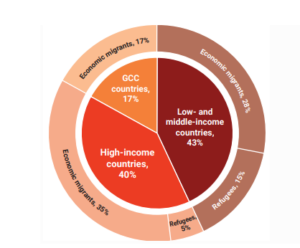(Relevant for Sociology Paper 1–Social Change & Development; Paper: 2 – Population Dynamics)
(NOTE)- Just Use Two to Five Points as Per Context of the Question. Never Make Sociology Answer A Current Affars Note sheet. Use Current Facts to Factually Substantiate Sociology Answers)
Highlights of the WDR 2023
- The share of working-age adults will drop sharply in many (developed) countries over the next few decades.
- Spain, with a population of 47 million, is projected to shrink by more than one-third by 2100, with those above age 65 increasing from 20 to 39% of the population.
- Most low-income countries are expected to see rapid population growth, putting them under pressure to create more jobs for young people.
- Migration is becoming more urgent due to severe divergences between and within countries – in terms of real wages, labour market opportunities, demographic patterns and climate costs.
- It can be a unique opportunity for economies and people as well as meet the growing needs of both origin and destination countries.
- Migrants transfer ideas, knowledge, and technology, spurring job creation and modernisation – just as US Silicon Valley expatriates did when they helped nurture India’s IT sector.
- As populations across the globe age at an unprecedented pace, the global competition for workers and talent will intensify.
- About 184 million people worldwide (including 37 million refugees) lack citizenship in the country in which they live.
Recommandation
- The WB proposed policies to harness economic opportunities and for better migration management in destination, transit and origin countries (to mitigate the risks that migrants face). For example,
- Origin countries should make labour migration an explicit part of their development strategy.
- Destination countries should facilitate their inclusion and address social impacts that raise concerns among their citizens.

Concepts (sociological concepts)
Migration
- According to the Demographic Dictionary of United Nations, “Migration is such an event in which people move from one geographical area to another geographical area. When people leaving their place of residence go to live permanently in another area then this is called migration.”
- Migration is the third factor for changes in the population, the other being birth rate and death rate.
- As compared to birth rate and death rate, migration affects the size of population differently. Migration is not a biological event like birth rate and death rate, but is influenced by the social, cultural, economic and political factors
- migration plays an important role in determining the distribution of population and supply of labour in the country.
Types of Migration
(i) Immigration and Emigration:
When people from one country move permanently to another country, for example, if people from India move to America then for America, it is termed as Immigration, whereas for India it is termed as Emigration.
(ii) In-migration and Out-migration:
In-migration means migration occurring within an area only, while out-migration means migration out of the area. Both types of migration are called internal migration occurring within the country. Migration from Bihar to Bengal is in-migration for Bengal, while it is out- migration for Bihar.
Effects
Migration affects rural areas (the place of origin) in the following ways
- When population migrates from rural areas, it reduces the pressure of population on land, the per worker output and productivity on land increases and so does per capita income.
- Migration reduces population growth in rural areas. Separation from wives for long periods and the use of contraceptives help control population growth. When very young males migrate to urban areas, they are so influenced by the urban life that they do not like to marry at an early age.
- Migration also affects the social set-up of rural communities. It weakens the joint family system if the migrants settle permanently in urban areas.
Migration affects urban areas
- Migration increases the population of the working class in urban areas. But the majority of migrants are young men between the ages of 15 to 24 years who are unwed
- The effects of migration on income and employment in urban areas are varied depending upon the type of migrants.
Migration from rural to urban areas has a number of adverse effects. Towns and cities in which the migrants settle, face innumerable problems. There is the prolific growth of huge slums and shantytowns.
-
Follow us :
https://www.instagram.com/triumphias
https://www.youtube.com/c/TriumphIAS
https://t.me/VikashRanjanSociology
Find More Blogs
Scope of the subject and comparison with other social sciences
Changing family structure in India Modernity and social changes in Europe
#Sociologyforupsc #sociologyforupscinhindi #sociologyforupscgs1 #sociologyforupscprelims #sociologyforupscinenglish #sociologyforupscmainsinhindi #sociologyforupscoptionalinhindi #sociologyforupscmains #sociologyforupscplaylist #sociologyforupsclecture1 #sociologyforupsccse #sociologyforupscoptional #syllabusofsociologyforupscoptional #bestbookforsociologyforupsc #sociologyoptionalforupscanswerwriting #sociologyoptionalforupscanukumari #sociologyoptionalforupscabhijeet #sociologyoptionalforupscanalysis #sociologyoptionalforupscalllectures #sociologysyllabusforupscanalysis

